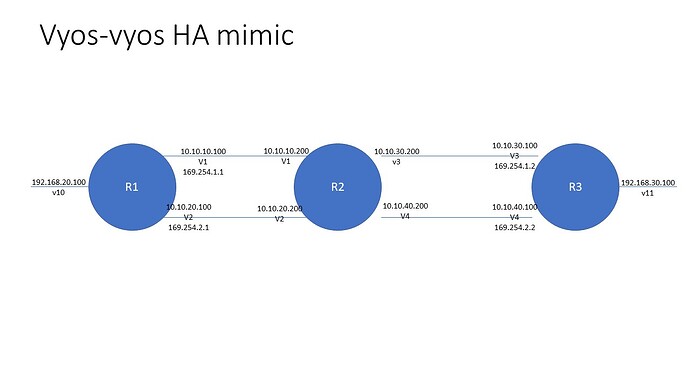Something is wrong or not sure I am not able to understad. In my same case for which I uploaded my diagram above. I created tables and applied default gateways
R1
set policy local-route rule 100 set table '100'
set policy local-route rule 100 source '10.10.10.100'
set policy local-route rule 150 set table '150'
set policy local-route rule 150 source '10.10.20.100'
set protocols static table 100 route 0.0.0.0/0 next-hop 10.10.10.200
set protocols static table 150 route 0.0.0.0/0 next-hop 10.10.20.200
And on R3
set policy local-route rule 100 set table '100'
set policy local-route rule 100 source '10.10.30.100'
set policy local-route rule 150 set table '150'
set policy local-route rule 150 source '10.10.40.100'
set protocols static table 100 route 0.0.0.0/0 next-hop 10.10.30.200
set protocols static table 150 route 0.0.0.0/0 next-hop 10.10.40.200
Now I try to ping 10.10.30.100 from R1
vyos@R1# ping 10.10.40.100
ping: connect: Network is unreachable
[edit]
vyos@R1# ^C
[edit]
vyos@R1# ping 10.10.30.100
ping: connect: Network is unreachable
[edit]
vyos@R1#
And from R3
vyos@R3# ping 10.10.10.100
ping: connect: Network is unreachable
[edit]
vyos@R3# ping 10.10.20.100
ping: connect: Network is unreachable
So in this case if the default gateway is added then I guess I should be able to ping other router interfaces?
I dont see routes are installed on my routing table.
vyos@R3# run show ip route
Codes: K - kernel route, C - connected, S - static, R - RIP,
O - OSPF, I - IS-IS, B - BGP, E - EIGRP, N - NHRP,
T - Table, v - VNC, V - VNC-Direct, A - Babel, F - PBR,
f - OpenFabric,
> - selected route, * - FIB route, q - queued, r - rejected, b - backup
t - trapped, o - offload failure
C>* 10.10.30.0/24 is directly connected, eth0, 00:29:40
C>* 10.10.40.0/24 is directly connected, eth2, 00:29:39
C>* 169.254.1.0/30 is directly connected, vti1, 00:10:46
C>* 169.254.2.0/30 is directly connected, vti2, 00:29:38
C>* 192.168.30.0/24 is directly connected, eth1, 00:29:40
[edit]
While table does apper
[edit]
vyos@R1# run show ip route table 100
Codes: K - kernel route, C - connected, S - static, R - RIP,
O - OSPF, I - IS-IS, B - BGP, E - EIGRP, N - NHRP,
T - Table, v - VNC, V - VNC-Direct, A - Babel, F - PBR,
f - OpenFabric,
> - selected route, * - FIB route, q - queued, r - rejected, b - backup
t - trapped, o - offload failure
VRF default table 100:
S>* 0.0.0.0/0 [1/0] via 10.10.10.200, eth0, weight 1, 00:17:29
[edit]
vyos@R1# run show ip route table 150
Codes: K - kernel route, C - connected, S - static, R - RIP,
O - OSPF, I - IS-IS, B - BGP, E - EIGRP, N - NHRP,
T - Table, v - VNC, V - VNC-Direct, A - Babel, F - PBR,
f - OpenFabric,
> - selected route, * - FIB route, q - queued, r - rejected, b - backup
t - trapped, o - offload failure
VRF default table 150:
S>* 0.0.0.0/0 [1/0] via 10.10.20.200, eth1, weight 1, 00:17:32
[edit]
vyos@R1#
